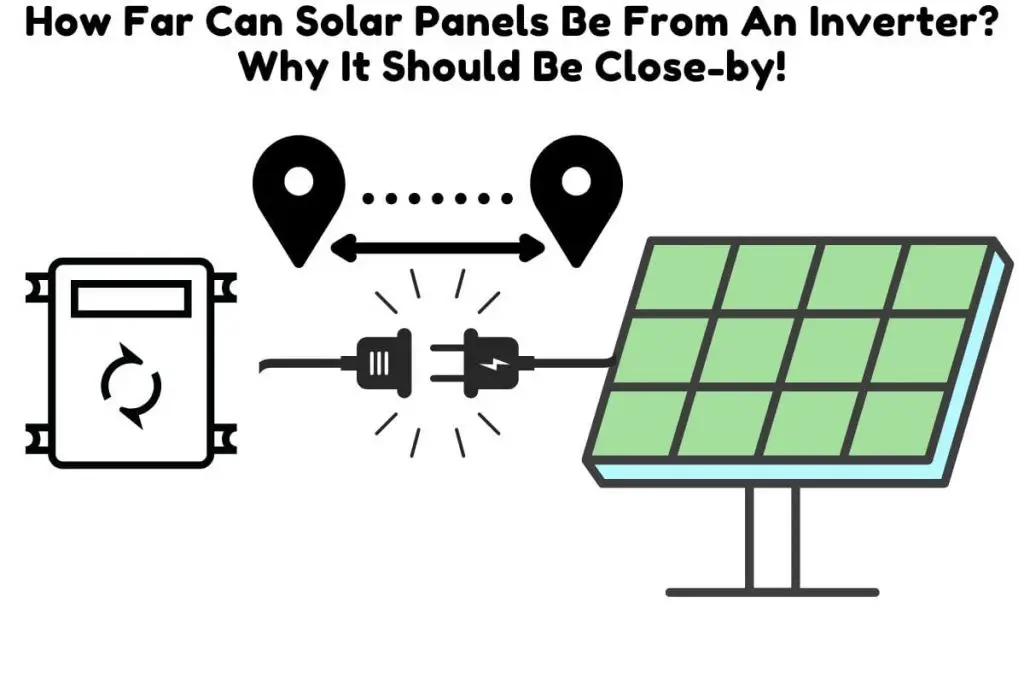An inverter should be installed as close to the solar panels as possible. The recommended distance is within 30 feet (9 meters). A shorter distance improves the efficiency of the system by minimizing voltage drop between the solar panels and the inverter.
Voltage drop means there is less electricity reaching the inverter from the solar panels. It is caused by resistance in the conductor or cable used to connect the inverter to the solar panels. Voltage drop can be minimized by having shorter cable runs between system components.
Poor design can reduce the efficiency of a solar system and directly contribute to power losses of up to 15%. Most of the loss is attributed to bad siting or location of the solar panels. However, up to 3% of losses are incurred at the inverter.
Most of the losses in a PV system can be avoided with careful planning. In today’s article, we look at the role of inverters in system efficiency. We look at what the ideal position for an inverter is as well as explain the difference between a “normal” inverter and a solar inverter.
On a side note! If you’re in need of a reliable and high-performance portable solar panel, We strongly recommend the Jackery SolarSaga 100W Portable Solar Panel (Amazon Link).
With a high conversion efficiency and foldable design, this solar panel is easy to transport and set up, making it perfect for outdoor activities like camping, hiking, and RV trips.

The US solar cell technology used in this panel ensures that you get the most efficient and reliable solar charging possible.
There is also a 60W option that is more affordable (Amazon Link)
Finally, we will look at some of the common faults or errors an inverter can experience and how to fix them.

What Is The Difference Between A Solar Inverter And A Normal Inverter?
Solar inverters are designed to work primarily with solar panels as their energy source. Normal inverters can be used with multiple energy sources including grid-supplied electricity, fuel-powered generators, and even solar panels.
Both solar and normal inverters convert direct current (DC) from an energy source into alternate current (AC) for use in an electrical appliance.
Solar panels, batteries, and some types of generators supply DC energy. Most appliances run on AC energy. In this case, you need something to convert the DC to AC energy and this is where both solar and normal inverters come in.
While solar and normal inverters are similar in terms of what they do, solar inverters have several functions that differentiate them. There are several types of solar inverters that serve different functions. These include grid-tie, off-grid, hybrid, and micro-inverters.
Grid-tie inverters are used in grid-tie systems. What sets off a grid-tie inverter from other inverters is its anti-islanding function. When the grid goes down, the inverter shuts the solar system off. This is to prevent the system from feeding electricity into the grid while it’s down.
Off-grid inverters are used in off-grid systems and don’t have the anti-islanding feature. This is because the system is not connected to the grid, hence there is no need for an automatic shutdown.
Hybrid inverters are a combination of grid-tie and off-grid inverters. They can be used in both a grid-tie or off-grid application and also do not have the anti-islanding feature.
Grid-tie, off-grid and hybrid inverters are all central inverters. This means there is only one inverter for the whole solar panel system. Micro-inverters are small inverters that connect to each solar panel. This means if your solar system has ten solar panels you will have ten microinverters, one for each panel. Source
Now you know what a solar inverter does and the different variations. But what’s the ideal location for a solar inverter?
Where Should I Place My Solar Inverter?
A solar inverter should be located close to the solar panels. It should be housed in a cool, dry space that allows airflow. While a solar inverter can be stored indoors or outdoors, it should be installed so that it does not get wet from rain or moisture.
A common practice is to install an inverter by mounting it onto a wall. This could be inside or outside the home. Care should be taken to ensure the inverter is placed where there is adequate ventilation and no direct sunshine as an inverter can get very hot.
How Far Should An Inverter Be From Batteries?
A solar inverter should be located within 10 feet (3 meters) of a battery bank. This ensures minimum losses from voltage drop due to cable length.
Just like how you want your solar panels to be as close as possible to your inverter, you also want the inverter to be as close as possible to the battery. This minimizes the length of cable you need to use which reduces voltage drop between the inverter and battery.
Voltage drop can be mitigated by using a thicker cable. If it’s not possible to have a short run between the inverter and batteries you can reduce the voltage drop by using a thicker gauge cable. The downside to this is a thicker cable will likely be more expensive.
For more on this, check out our post ” How Far Can Solar Panels Be from Battery and Other Components?
Also, check out “How Far Can Solar Panels Be From A House? Why It Shouldn’t Be Too Far!“
Why Would A Solar Inverter Stop Working?
A malfunction in a solar inverter could be caused by the other components in the system. This could be solar panels or batteries. Alternatively, it could be caused by misconnection, overheating, short circuits, or a burnt fuse.
There are several reasons why an inverter would stop working. Fortunately, modern inverters have screens that can indicate the source of the problem. Using the error codes, you can diagnose the problem and correct it. If not, there are some basic steps you can take to work out what the issue is.
The first thing to do is to make sure the problem is not at the power generation point. This is where the power is coming from. This could be either the solar panels or the batteries. The problem might just be as simple as the inverter not getting enough power.
If they are working correctly the next thing you would check would be the connections between the inverter and the solar panels or battery. Very often, a solar system will malfunction because of faulty or incorrect connections.
Another very common problem with inverters is incorrect programming. Typically, an inverter will come with a manual that gives specific instructions on how to pair the inverter with your solar panels or batteries.
Overheating can also cause an inverter to malfunction. This is why installing it where there is adequate airflow is important. Overheating usually manifests as decreased output. If the inverter is producing less than normal check to see if it isn’t hot. Source
